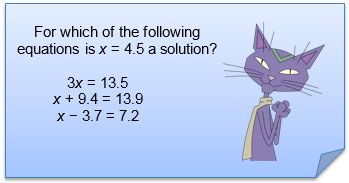
Source: Mother cat, rones, Open Clipart
In the previous sections, you used two different models to solve equations: algebra tiles and cups and counters. When you were given an equation, you used models as well as inverse operations to determine the solution to the equation.
In this section, you will work backwards. If you have a possible solution, you will use substitution to determine if that value really is a solution to a given equation.

Source: Mother cat, rones, Open Clipart
![]() Use the interactive below to see how three students, Emily, Ly, and Dashon determined whether or not x = 4.5 is a solution to each equation. Click on each student in the picture below to see how they approached one of the three equations. In this interactive, you will need to know that the symbol,
Use the interactive below to see how three students, Emily, Ly, and Dashon determined whether or not x = 4.5 is a solution to each equation. Click on each student in the picture below to see how they approached one of the three equations. In this interactive, you will need to know that the symbol,  , an equal sign with a question mark above it means "might be equal to."
, an equal sign with a question mark above it means "might be equal to."
Source: IMG_1505, AFS-USA Intercultural Programs, Flickr
Use the interactive to answer the questions that follow.
Interactive popup. Assistance may be required.
Only two equations: 3x = 13.5 and x + 9.4 = 13.9.
Interactive popup. Assistance may be required.
Each student used substitution. They substituted 4.5 for the value of x in each equation, and then simplified the left side of the equation to see if it generated the same value as the right side of the equation.
Interactive popup. Assistance may be required.
If the value of x is a solution to the equation, then the left side of the equation has the same value as the right side of the equation.
Interactive popup. Assistance may be required.
Substitute -5 for the variable in each equation. Determine which substitution generates a true statement (i.e., a statement that is true, such as 5 = 5).
Interactive popup. Assistance may be required.
The area of a rectangle is found using the formula A = lw. Use this formula to write an equation in terms of x, and then determine if x = 8 is the solution to this equation.